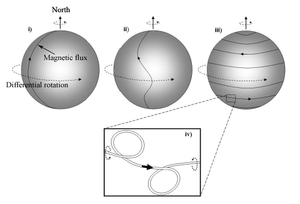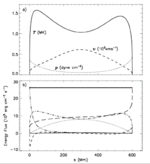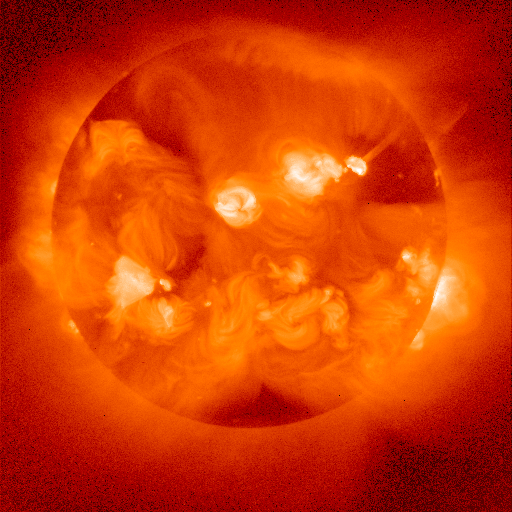
Coronal loop
Encyclopedia

Corona
A corona is a type of plasma "atmosphere" of the Sun or other celestial body, extending millions of kilometers into space, most easily seen during a total solar eclipse, but also observable in a coronagraph...
and transition region of the Sun
Sun
The Sun is the star at the center of the Solar System. It is almost perfectly spherical and consists of hot plasma interwoven with magnetic fields...
. These highly structured and elegant loops are a direct consequence of the twisted solar magnetic flux within the solar body. The population of coronal loops can be directly linked with the solar cycle
Solar cycle
The solar cycle, or the solar magnetic activity cycle, is a periodic change in the amount of irradiation from the Sun that is experienced on Earth. It has a period of about 11 years, and is one component of solar variation, the other being aperiodic fluctuations. Solar variation causes changes in...
; it is for this reason coronal loops are often found with sunspots at their footpoints. The upwelling magnetic flux pushes through the photosphere
Photosphere
The photosphere of an astronomical object is the region from which externally received light originates. The term itself is derived from Ancient Greek roots, φῶς, φωτός/phos, photos meaning "light" and σφαῖρα/sphaira meaning "sphere", in reference to the fact that it is a spheric surface perceived...
, exposing the cooler plasma below. The contrast between the photosphere and the solar interior gives the impression of dark spots, or sunspots.
Physical features
A coronal loop is magnetic fluxFlux
In the various subfields of physics, there exist two common usages of the term flux, both with rigorous mathematical frameworks.* In the study of transport phenomena , flux is defined as flow per unit area, where flow is the movement of some quantity per time...
fixed at both ends, threading through the solar body, protruding into the solar atmosphere. They are ideal structures to observe when trying to understand the transfer of energy from the solar body, through the transition region and into the corona.

Solar wind
The solar wind is a stream of charged particles ejected from the upper atmosphere of the Sun. It mostly consists of electrons and protons with energies usually between 1.5 and 10 keV. The stream of particles varies in temperature and speed over time...
and reach far into the corona and heliosphere. Anchored in the photosphere (a rigid, line-tied
Magnetohydrodynamics
Magnetohydrodynamics is an academic discipline which studies the dynamics of electrically conducting fluids. Examples of such fluids include plasmas, liquid metals, and salt water or electrolytes...
, anchor is assumed where the high-β, external plasma holds the loop footpoints in place), coronal loops project through the chromosphere
Chromosphere
The chromosphere is a thin layer of the Sun's atmosphere just above the photosphere, roughly 2,000 kilometers deep....
and transition region, extending high into the corona
Corona
A corona is a type of plasma "atmosphere" of the Sun or other celestial body, extending millions of kilometers into space, most easily seen during a total solar eclipse, but also observable in a coronagraph...
.
Also, coronal loops have a wide variety of temperatures along their lengths. Loops existing at temperatures below 1 MK are generally known as cool loops, those existing at around 1 MK are known as warm loops, and those beyond 1 MK are known as hot loops. Naturally, these different categories radiate at different wavelengths.

Location
Coronal loops populate both active and quiet regions of the solar surface. Active regions on the solar surface take up small areas but produce the majority of activity and are often the source of flares and Coronal Mass EjectionCoronal mass ejection
A coronal mass ejection is a massive burst of solar wind, other light isotope plasma, and magnetic fields rising above the solar corona or being released into space....
s due to the intense magnetic field
Magnetic reconnection
Magnetic reconnection is a physical process in highly conducting plasmas in which the magnetic topology is rearranged and magnetic energy is converted to kinetic energy, thermal energy, and particle acceleration...
present. Active regions produce 82% of the total coronal heating energy. Coronal holes are open field lines located predominantly in the polar
Geographical pole
A geographical pole is either of the two points—the north pole and the south pole—on the surface of a rotating planet where the axis of rotation meets the surface of the body...
regions of the Sun and are known to be the source of the fast solar wind
Solar wind
The solar wind is a stream of charged particles ejected from the upper atmosphere of the Sun. It mostly consists of electrons and protons with energies usually between 1.5 and 10 keV. The stream of particles varies in temperature and speed over time...
. The quiet Sun makes up the rest of the solar surface. The quiet Sun, although less active than active regions, is awash with dynamic
Dynamics (mechanics)
In the field of physics, the study of the causes of motion and changes in motion is dynamics. In other words the study of forces and why objects are in motion. Dynamics includes the study of the effect of torques on motion...
processes and transient
Transient astronomical event
A transient astronomical event, often simply called in context by astronomers a transient, is an astronomical object or phenomenon which can be observed for a short period of time...
events (bright points, nanoflares
Nanoflares
A nanoflare is a very small solar flare which happens in the corona, the external atmosphere of the Sun.The hypothesis of "microflares" as a possible explanation of the coronal heating was first suggested by Gold and then later developed by Eugene Parker....
and jets). As a general rule, the quiet Sun exists in regions of closed magnetic structures, and active regions are highly dynamic sources of explosive events. It is important to note that observations suggest the whole corona is massively populated by open and closed magnetic fieldlines.
Coronal loops and the coronal heating problem
A closed fieldline does not constitute a coronal loop; however, closed flux must be filled with plasma before it can be called a coronal loop. With this in mind, it becomes clear that coronal loops are a rarity on the solar surface, as the majority of closed-flux structures are empty. This means the mechanism that heats the corona and injects chromospheric plasma into the closed magnetic flux is highly localised. The mechanism behind plasma filling, dynamic flows and coronal heating remains a mystery. The mechanism(s) must be stable enough to continue to feed the corona with chromospheric plasma and powerful enough to accelerate and therefore heat the plasma from 6000 K to well over 1 MK over the short distance from the chromosphere and transition region to the corona. This is the very reason coronal loops are targeted for intense study. They are anchored to the photosphere, are fed by chromospheric plasma, protrude into the transition region and exist at coronal temperatures after undergoing intensive heating.
1946–1975
Many strides have been made by ground-based telescopes (such as the Mauna Loa Solar ObservatoryMauna Loa Solar Observatory
The Mauna Loa Solar Observatory is a collection of instruments for observing the sun located on the slopes of the Mauna Loa volcano on the island of Hawaii, USA at an elevation of .-General information:...
, MLSO, in Hawaii
Hawaii
Hawaii is the newest of the 50 U.S. states , and is the only U.S. state made up entirely of islands. It is the northernmost island group in Polynesia, occupying most of an archipelago in the central Pacific Ocean, southwest of the continental United States, southeast of Japan, and northeast of...
) and eclipse
Eclipse
An eclipse is an astronomical event that occurs when an astronomical object is temporarily obscured, either by passing into the shadow of another body or by having another body pass between it and the viewer...
observations of the corona, but to escape the obscuring effect of the Earth
Earth
Earth is the third planet from the Sun, and the densest and fifth-largest of the eight planets in the Solar System. It is also the largest of the Solar System's four terrestrial planets...
's atmosphere, space-based observations have become a necessary evolution for solar physics. Beginning with the short (seven-minute) Aerobee rocket flights in 1946 and 1952, spectrogram
Spectrogram
A spectrogram is a time-varying spectral representation that shows how the spectral density of a signal varies with time. Also known as spectral waterfalls, sonograms, voiceprints, or voicegrams, spectrograms are used to identify phonetic sounds, to analyse the cries of animals; they were also...
s measured solar EUV and Lyman-α emissions. Basic X-ray
X-ray
X-radiation is a form of electromagnetic radiation. X-rays have a wavelength in the range of 0.01 to 10 nanometers, corresponding to frequencies in the range 30 petahertz to 30 exahertz and energies in the range 120 eV to 120 keV. They are shorter in wavelength than UV rays and longer than gamma...
observations were attained by 1960 using such rockets. The British Skylark rocket
Skylark (rocket)
Skylark was a British sounding rocket design. The Skylark was first launched in 1957 from Woomera, Australia and its 441st and final launch took place from Esrange, Sweden on 2 May 2005...
missions from 1959 to 1978 also returned mainly X-ray spectrometer
Spectrometer
A spectrometer is an instrument used to measure properties of light over a specific portion of the electromagnetic spectrum, typically used in spectroscopic analysis to identify materials. The variable measured is most often the light's intensity but could also, for instance, be the polarization...
data. Although successful, the rocket missions were very limited in lifetime and payload. During the period of 1962–1975, the satellite series Orbiting Solar Observatory
Orbiting Solar Observatory
The Orbiting Solar Observatory Program was the name of a series of nine American science satellites primarily intended to study the Sun, though they also included important non-solar experiments. Eight were launched successfully by NASA between 1962 and 1975 using Delta rockets...
(OSO-1 to OSO-8) were able to gain extended EUV and X-ray spectrometer observations. Then, in 1973, Skylab
Skylab
Skylab was a space station launched and operated by NASA, the space agency of the United States. Skylab orbited the Earth from 1973 to 1979, and included a workshop, a solar observatory, and other systems. It was launched unmanned by a modified Saturn V rocket, with a mass of...
was launched and began a new multi-wavelength campaign that typified future observatories. This mission lasted only a year and was superseded by the Solar Maximum Mission
Solar Maximum Mission
The Solar Maximum Mission satellite was designed to investigate solar phenomenon, particularly solar flares. It was launched on February 14, 1980....
, which became the first observatory to last the majority of a solar cycle
Solar cycle
The solar cycle, or the solar magnetic activity cycle, is a periodic change in the amount of irradiation from the Sun that is experienced on Earth. It has a period of about 11 years, and is one component of solar variation, the other being aperiodic fluctuations. Solar variation causes changes in...
(from 1980 to 1989). A wealth of data was accumulated across the whole range of emission.
1991–present day
The solar community was rocked by the launch of YohkohYohkoh
Yohkoh , known before launch as Solar-A, was a Solar observatory spacecraft of the Institute of Space and Astronautical Science with United States and United Kingdom collaboration...
(Solar A) from Kagoshima Space Centre in August 1991. It was lost on 14 December 2001 due to battery failure but revolutionised X-ray observations in its decade of operations. Yohkoh (or Sunbeam) orbited the Earth in an elliptical orbit
Orbit
In physics, an orbit is the gravitationally curved path of an object around a point in space, for example the orbit of a planet around the center of a star system, such as the Solar System...
, observing X-ray and γ-ray
Gamma ray
Gamma radiation, also known as gamma rays or hyphenated as gamma-rays and denoted as γ, is electromagnetic radiation of high frequency . Gamma rays are usually naturally produced on Earth by decay of high energy states in atomic nuclei...
emissions from solar phenomena such as solar flares. Yohkoh carried four instruments. The Bragg Crystal Spectrometer (BCS), the Wide Band Spectrometer (WBS), the Soft X-Ray Telescope (SXT
Yohkoh
Yohkoh , known before launch as Solar-A, was a Solar observatory spacecraft of the Institute of Space and Astronautical Science with United States and United Kingdom collaboration...
) and the Hard X-Ray Telescope (HXT) were operated by a consortium of scientists from Japan, the USA and the UK. Of particular interest is the SXT
Yohkoh
Yohkoh , known before launch as Solar-A, was a Solar observatory spacecraft of the Institute of Space and Astronautical Science with United States and United Kingdom collaboration...
instrument for observing X-ray-emitting coronal loops.

TRACE
TRACE was a NASA space telescope designed to investigate the connections between fine-scale magnetic fields and the associated plasma structures on the Sun by providing high resolution images and observation of the solar photosphere and transition region to the corona...
coronal loops radiating in the EUV wavelengths.
The next major step in solar physics came at the launch of the Solar and Heliospheric Observatory
Solar and Heliospheric Observatory
The Solar and Heliospheric Observatory is a spacecraft built by a European industrial consortium led by Matra Marconi Space that was launched on a Lockheed Martin Atlas IIAS launch vehicle on December 2, 1995 to study the Sun, and has discovered over 2100 comets. It began normal operations in May...
(SOHO) in December 1995 from Cape Canaveral Air Force Station
Cape Canaveral Air Force Station
Cape Canaveral Air Force Station is an installation of the United States Air Force Space Command's 45th Space Wing, headquartered at nearby Patrick Air Force Base. Located on Cape Canaveral in the state of Florida, CCAFS is the primary launch head of America's Eastern Range with four launch pads...
in Florida
Florida
Florida is a state in the southeastern United States, located on the nation's Atlantic and Gulf coasts. It is bordered to the west by the Gulf of Mexico, to the north by Alabama and Georgia and to the east by the Atlantic Ocean. With a population of 18,801,310 as measured by the 2010 census, it...
, USA. SOHO originally had an operational lifetime of two years. The mission was extended to March 2007 due to its resounding success, allowing SOHO to observe a complete 11-year solar cycle. SOHO continually faces the Sun holding a slow orbit around the First Lagrangian Point
Lagrangian point
The Lagrangian points are the five positions in an orbital configuration where a small object affected only by gravity can theoretically be stationary relative to two larger objects...
(L1), where the gravitational balance between the Sun and Earth provides a stable position for SOHO to orbit. SOHO is continually eclipsing the Sun from the Earth at a distance of approximately 1.5 million kilometres.
SOHO is managed by scientists from the European Space Agency
European Space Agency
The European Space Agency , established in 1975, is an intergovernmental organisation dedicated to the exploration of space, currently with 18 member states...
(ESA) and NASA. Containing more instruments than both TRACE and Yohkoh, this large solar mission was designed to look at the chain from the solar interior, the solar corona to the solar wind. SOHO has 12 instruments on board, including the Coronal Diagnostic Spectrometer (CDS), the Extreme ultraviolet Imaging Telescope (EIT), the Solar Ultraviolet Measurements of Emitted Radiation (SUMER) and the UltraViolet Coronagraph Spectrometer (UVCS), which are all used extensively in the study of the transition region and corona.
The EIT instrument is used extensively in coronal loop observations. EIT images the transition region through to the inner corona by utilising four band passes, 171 Å FeIX, 195 Å FeXII, 284 Å FeXV and 304 Å HeII, each corresponding to different EUV temperatures, probing the chromospheric network to the lower corona.
The Transition Region And Coronal Explorer
TRACE
TRACE was a NASA space telescope designed to investigate the connections between fine-scale magnetic fields and the associated plasma structures on the Sun by providing high resolution images and observation of the solar photosphere and transition region to the corona...
(TRACE
TRACE
TRACE was a NASA space telescope designed to investigate the connections between fine-scale magnetic fields and the associated plasma structures on the Sun by providing high resolution images and observation of the solar photosphere and transition region to the corona...
) was launched in April 1998 from Vandenberg Air Force Base
Vandenberg Air Force Base
Vandenberg Air Force Base is a United States Air Force Base, located approximately northwest of Lompoc, California. It is under the jurisdiction of the 30th Space Wing, Air Force Space Command ....
as part of NASA's Goddard Space Flight Center Small Explorer (SMEX) project. The small orbiting instrument has a 30×160 cm, 8.66 m focal length Cassegrain telescope with a 1200×1200px CCD detector. The timing of the launch was planned to coincide with the rising phase of the solar maximum. Observations of the transition region and lower corona could then be carried out in conjunction with SOHO to give an unprecedented view of the solar environment during this exciting phase of the solar cycle.

Dynamic flows
All of the above space missions have been highly successful in observing strong plasma flows and highly dynamic processes in coronal loops. For example, SUMER observations suggest flow velocities of 5–16 km/s in the solar disk, and otherjoint SUMER/TRACE observations detect flows of 15–40 km/s. Very high velocities have been detected by the Flat Crystal Spectrometer (FCS) on board the Solar Maximum Mission, where plasma velocities were found in the range of 40–60 km/s.
New missions

Useful links
- The new solar observatory Hinode (Solar-B)HinodeHinode , formerly Solar-B, is a Japan Aerospace Exploration Agency Solar mission with United States and United Kingdom collaboration. It is the follow-up to the Yohkoh mission and it was launched on the final flight of the M-V-7 rocket from Uchinoura Space Center, Japan on 22 September 2006 at...
- The highly successful solar X-ray mission, Yohkoh (Solar-A)YohkohYohkoh , known before launch as Solar-A, was a Solar observatory spacecraft of the Institute of Space and Astronautical Science with United States and United Kingdom collaboration...
- TRACE homepage
- Solar and Heliospheric Observatory, including near-real-time images of the solar corona
- Coronal heating problem at Innovation Reports
- NASA/GSFC description of the coronal heating problem
- FAQ about coronal heating
- Animated explanation of Coronal loops and their role in creating Prominences (University of Glamorgan)

